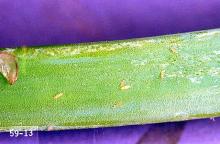Includes
Onion thrips (Thrips tabaci)
Western flower thrips (Frankliniella occidentalis)
Pest description and crop damage Adults are small, slender, feather-wing insects. They are yellow to light brown and about 0.06 inch long. The young are wingless. They feed on foliage, reduce plant vigor, and may kill tops. Thrips can be vectors of disease in onion crops. Onion thrips are not damaging once seed heads have formed. Western flower thrips, which feed on pollen without damaging seed, often are most prevalent in the flower heads. It rarely is justified to treat for thrips beyond the initial early application.
Management-chemical control
- azadirachtin (Neemix 4.5) at 7 to 16 fl oz/A (0.021 to 0.049 lb ai/A). PHI 0 days. REI 4 hr. In most cases, apply at high rate. This botanical pesticide acts slowly. Repeat in 7 to 10 days as needed. Spray early and check for effects. Some formulations are OMRI-listed for organic production.
- spirotetramat (Movento) at 5 fl oz/A (0.08 lb ai/A). Apply no more than 10 fl oz/A (0.15 lb ai/A) per crop season with a minimum treatment interval of 7 days. PHI 3 days (members of Subgroup 3-07A); 7 days (members of Subgroup 3-07B). For onions, leeks, and chives grown for seed production, do not apply 4 months prior to bloom, during bloom or until after petal fall.
- spirotetramat (Movento HL) at 2.5 fl oz/A (0.07 lb ai/A). Apply no more than 5 fl oz/A (0.16 lb ai/A) per crop season with a minimum treatment interval of 7 days. PHI 3 days (members of Subgroup 3-07A); 7 days (members of Subgroup 3-07B). For onions, leeks, and chives grown for seed production, do not apply 4 months prior to bloom, during bloom or until after petal fall.

